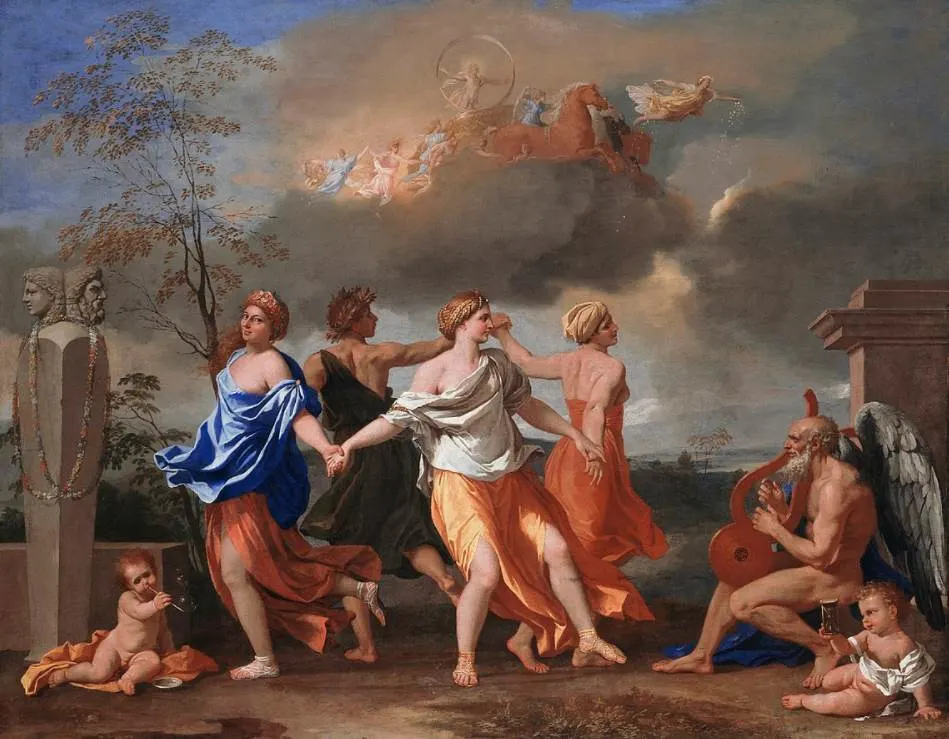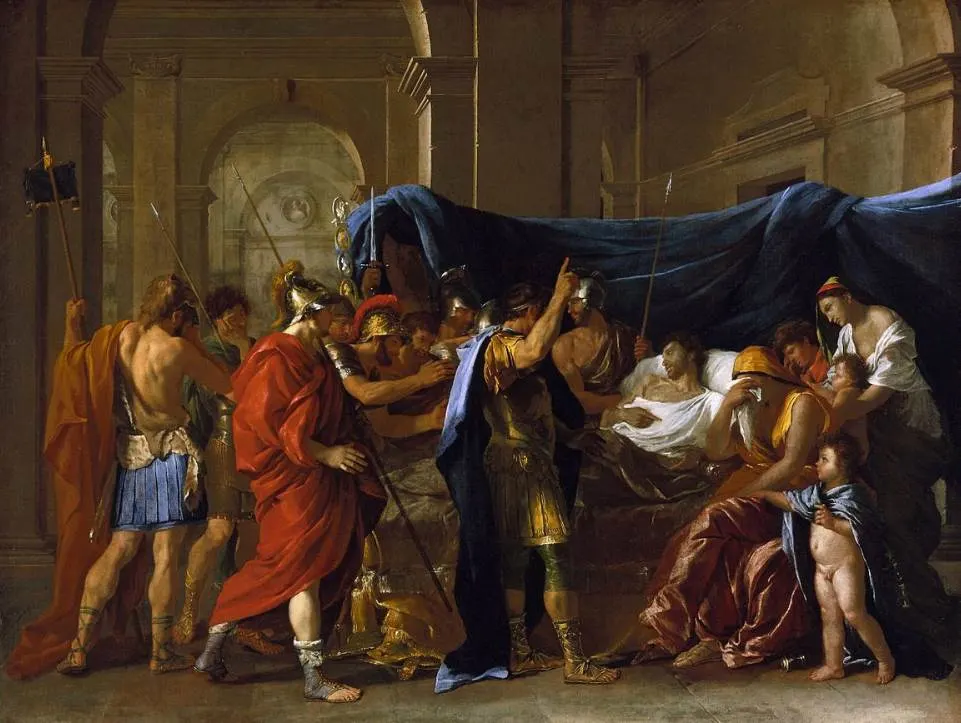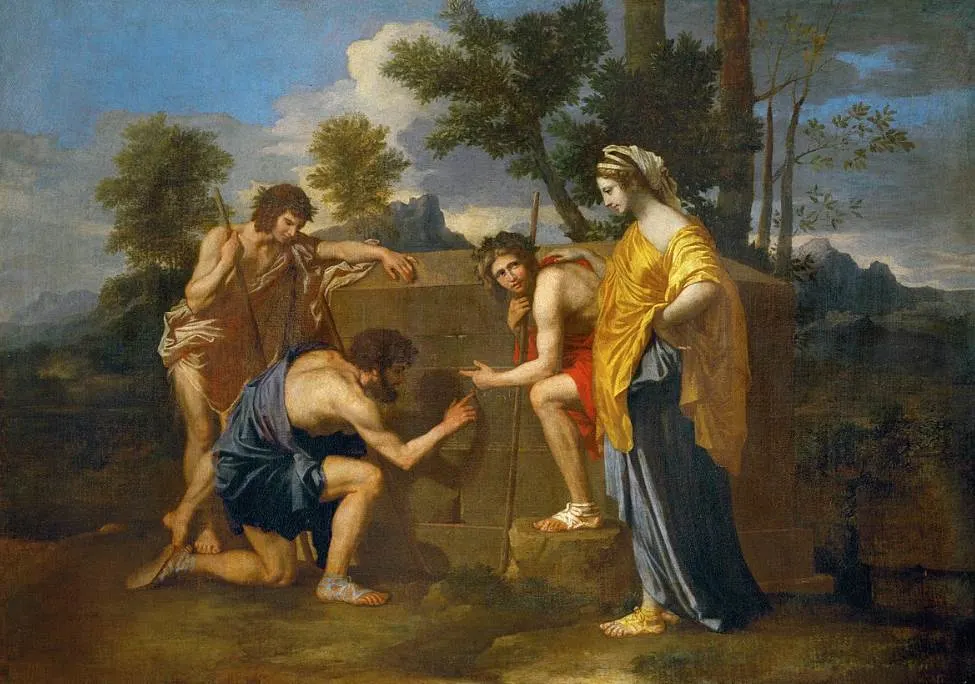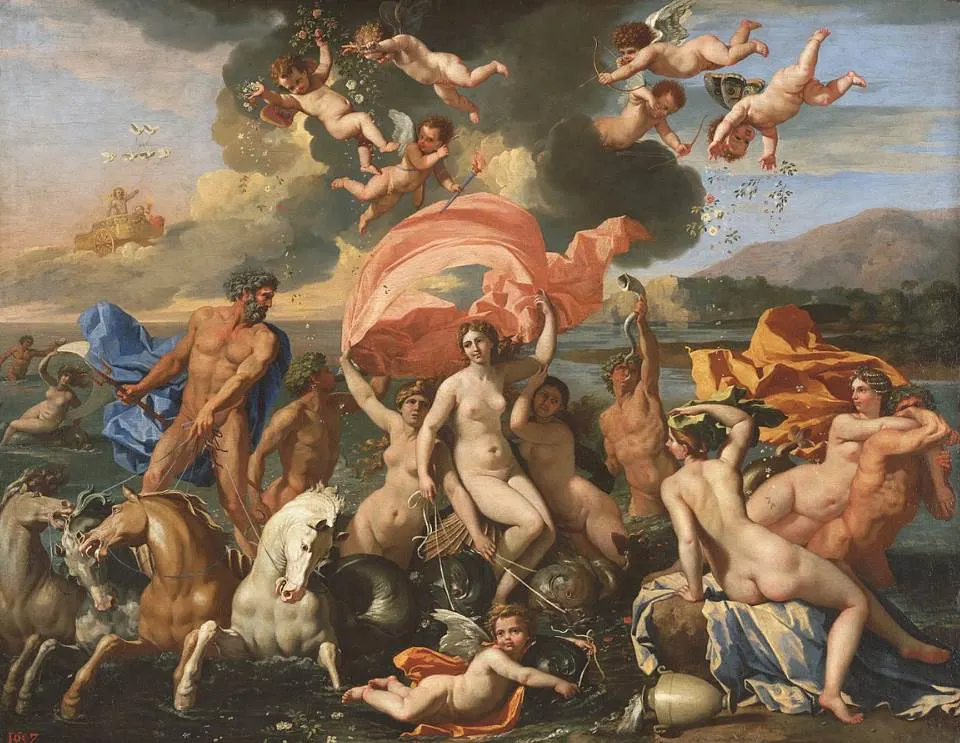When Nicolas Poussin (1594-1665) moved from France to Rome during the 1620s, The French artist only briefly returned once to his home country.
He had made a name for himself in the Italian capital since his arrival in 1624. When he returned to France, he was overloaded with work by King Louis XIII and Cardinal Richelieu and quickly returned to Rome.
The Baroque artist became famous for his magnificent representations of mythological and religious paintings in a classical context.
Clarity, harmonious figures in a classical setting, and impeccable compositional lines define his oeuvre.
His paintings became one of the main inspirations for Necialssical artists such as Jacques-Louis David (1748-1825) and Jean-Auguste-Dominique Ingres (1780-1867) nearly two centuries later.
Below, you’ll find some of the most famous Nicolas Poussin paintings so you can get a clear visual idea about the talent of this remarkable 17th-century artist.
1. A Dance to the Music of Time
- Date created: 1634-1636
- Dimensions: 82.5 × 104 centimeters (32.5 × 41 inches)
- Location: Wallace Collection, London, United Kingdom
A Dance to the Music of Time is one of the most ambiguous paintings by Nicolas Poussin. It was commissioned by Giulio Rospigliosi, a man who became Pope Clement IX later on in his life. This emphasizes the fact that Poussin was already a well-respected artist in Rome in the 1630s.
It depicts a group of 4 people dancing in a circle while an allegorical representation of time is playing the lyre. In the background, we can see Aurora and Apollo, the goddess of dawn and the sun god respectively, being pulled by a chariot. The original name of the painting is “The Four Seasons.”

2. The Death of Germanicus
- Date created: 1627
- Dimensions: 147,96 × 198,12 centimeters (5,82 × 7,8 inches)
- Location: Minneapolis Institute of Art, Minneapolis, United States
The Death of Germanicus was one of the first major commissions that Poussin completed upon his arrival in Rome. It was commissioned by Cardinal Francesco Barberini (1597–1679), the nephew of Pope Urban VIII. He was a representative of the Catholic Church in France and might have known Poussin before he came to Rome.

The painting depicts the death of an important Roman general named Germanicus. He was the leader brother of Roman Emperor Claudius who worked in the service of Emperor Tiberius. His name is derived from important victories in Germania on the northern border of the Roman Empire. Art historians have claimed that he was poisoned by the emperor himself.

3. Et in Arcadia ego (The Arcadian Shepherds)
- Date created: 1637-1638
- Dimensions: 85 × 121 centimeters (34.25 × 47.24 inches)
- Location: Louvre Museum, Paris, France
Et in Arcadia ego is a painting also known as “The Arcadian Shepherds,” a reference to the inscription that can be seen on the tomb in the work. We can see a pastoral scene in an idyllic setting featuring several shepherds who are wearing ancient clothes.
Arcadia is a locality in Greece that has become a synonym for pastoral harmony. This painting overflows with it, a common trait of Nicolas Poussin’s paintings. The painting at the Louvre Museum is the second version that Poussin produced. He painted the first version a decade earlier and this painting can be admired at Chatsworth House in Derbyshire, England.

4. The Triumph of Pan
- Date created: 1636
- Dimensions: 135.9 × 146 centimeters (53.5 × 57.4 inches)
- Location: National Gallery, London, United Kingdom
The Triumph of Pan is one of several chaotic paintings by Nicolas Poussin. It depicts a lavish party in a woodland area full of laughter and drinking, centered around a statue of a red-faced satyr with horns that might represent Pan, the god of shepherds and herdsmen.
Because both deities are related to the Roman god of wine, Bacchus, the scene has an abundant amount of heavenly grape juice. It’s possible that the painting is Poussin’s interpretation of the so-called Bacchanalian festivals. These were held in ancient Rome to ensure a good harvest season.

5. Landscape with Saint John on Patmos
- Date created: 1640
- Dimensions: 100.3 × 136.4 centimeters (39.5 × 53.7 inches)
- Location: Art Institute of Chicago, Chicago, United States
Landscape with Saint John on Patmos is one of several landscape paintings by Nicolas Poussin. It depicts Saint John who was banished to Patmos, a Greek island in the Aegean Sea. We can see him writing the Book of Revelation, the final book of the New Testament.
Poussin wasn’t merely a landscape painter and this is obvious in this fascinating work of art. The background is dominated by ancient monuments such as an obelisk and temples. Saint John appears to be working inside the ruins of an ancient Greek temple as well.

6. Triumph of Neptune and Amphitrite
- Date created: 1635-1636
- Dimensions: 97.23 x 108.07 centimeters (38.27 x 42.55 inches)
- Location: Philadelphia Museum of Art, Philadelphia, United States
Triumph of Neptune and Amphitrite is an exuberant mythological in which we can see a large number of nude figures near the sea. The main figure o the left of Poseidon or Neptune, the god of the sea, who is pulled by three horses that appear to be emerging from the water.
It’s unclear whether the woman in the central part of the painting is Venus, Amphitrite, or Galatea. Amphiritite is the wife of Poseidon according to Greek mythology, so this makes the most sense. Above their heads, putti are seen sprinkling flowers on top of the main characters.

7. The Nurture of Jupiter
- Date created: Mid-1630s
- Dimensions: 96.5 x 121 centimeters (37.99 x 47.63 inches)
- Location: Dulwich Picture Gallery, London, United Kingdom
The Nurture of Jupiter is also sometimes referred to as “The Childhood of Jupiter.” It depicts the infant Jupiter, the son of Saturn, and his wife who gave birth to him in a hiding place on the modern-day island of Crete. She ran away because Saturn devoured his sons out of fear of being overthrown by them in the future.
We can see the infant child being fed milk from the goat Amalthea. This has been a popular subject in the history of art because it’s quite a remarkable story from Greek mythology. The scene takes place on the flanks of Mount Ida in Crete.

8. The Abduction of the Sabine Women
- Date created: 1637-1638
- Dimensions: 159 x 206 centimeters (62.5 x 81.1 inches)
- Location: Louvre Museum, Paris, France
The Abduction of the Sabine Women is another Roman mythological story in which young women and girls from neighboring areas were massively abducted by Roman men. This event presumably took place shortly after Rome was founded in the mid-8th century B.C.
This abduction, also sometimes known as the “Rape of the Sabine Women,” was done by Romulus, the legendary founder of Rome, and how followers. This was initiated by a new law imposed by the Sabines in which their women couldn’t marry Romans. This story has been the subject of countless works of art since the Renaissance.

9. Blind Orion Searching for the Rising Sun
- Date created: 1658
- Dimensions: 119.1 × 182.9 centimeters (46.9 × 72 inches)
- Location: MET Museum, New York City, United States
Blind Orion Searching for the Rising Sun is a painting with a relatively self-describing title. We can see the mythological figure Orion who is blinded and is looking for the rising sun. Orion was a huntsman who was placed among the stars by Zeus, forming the constellation with the same name.
The painting was completed in the final decade of the artist’s life and some art historians have claimed that it’s among the best landscape paintings that Poussin ever produced. The story of Orion was derived from the works of a 2nd-century Syrian writer named Lucian.

10. The Four Seasons
- Date created: 1660-1664
- Dimensions: 118 x 160 centimeters (46.4 x 62.9 inches)
- Location: Louvre Museum, Paris, France
The Four Seasons is the name of a collection of 4 oil paintings and the final paintings that Nicolas Poussin worked on before his death in 1665. He painted allegorical paintings of Spring, Summer, Autumn, and Winter, featuring figures of the Old Testament.
Poussin managed to complete these paintings while his health was failing. They hold a special place in the artist’s oeuvre due to their inventiveness and can be described as representations of Poussin’s talent and style. They hang in a specially dedicated room inside the Louvre Museum.

